 My idea for this bicycle was to install VO Porteur handlebars with Silver bar-end shifters and Guidonnet brake levers. In theory this seemed like a good plan, but in practice several things have gone awry...
My idea for this bicycle was to install VO Porteur handlebars with Silver bar-end shifters and Guidonnet brake levers. In theory this seemed like a good plan, but in practice several things have gone awry...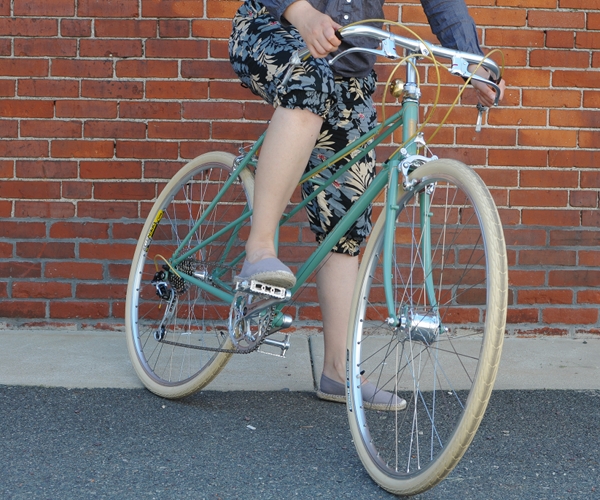 First, the stem length we thought would work (6cm) is apparently too short, because when I lower the bars down to where I want them, the bar-ends overlap too much with my knee if I sharply turn the handlebars while the pedal is in the up position. So we had to exchange the stem, and thankfully the shop that sold it to us was willing to do that. We are now installing a 10cm stem and will see whether that eliminates the overlap.
First, the stem length we thought would work (6cm) is apparently too short, because when I lower the bars down to where I want them, the bar-ends overlap too much with my knee if I sharply turn the handlebars while the pedal is in the up position. So we had to exchange the stem, and thankfully the shop that sold it to us was willing to do that. We are now installing a 10cm stem and will see whether that eliminates the overlap.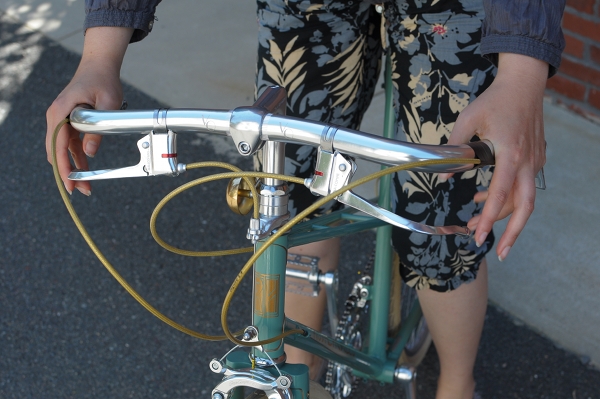 But the bigger problem is the Guidonnetbrake levers themselves. They look fantastically French and provide plenty of braking power, but I find their placement awkward.
But the bigger problem is the Guidonnetbrake levers themselves. They look fantastically French and provide plenty of braking power, but I find their placement awkward.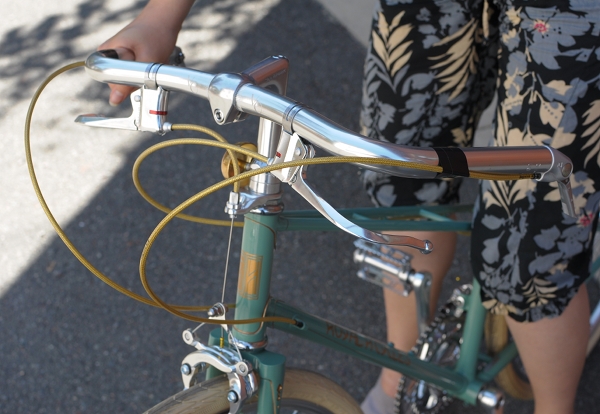 As you can see in the pictures, the Guidonnets are shaped like a pair of short rod-brake levers. They are installed in such a way, that their curve is meant to follow the curve of the handlebars. And because the Porteur bars are quite narrow, my hands end up in a position that is too close to the stem when braking - which I find suboptimal in its effect on the bicycle's handling.
As you can see in the pictures, the Guidonnets are shaped like a pair of short rod-brake levers. They are installed in such a way, that their curve is meant to follow the curve of the handlebars. And because the Porteur bars are quite narrow, my hands end up in a position that is too close to the stem when braking - which I find suboptimal in its effect on the bicycle's handling.{Edited to add: I have now test-ridden the bicycle with these brake levers extensively. When going over 12mph, the handling in this position stabilizes; slower than that it is somewhat shaky. It is basically a very aggressive position close to the stem, similar to the "fixie grip". The levers are good if you want a bike with swept-back bars to handle aggressively in city traffic. The levers are not so good if you don't.}
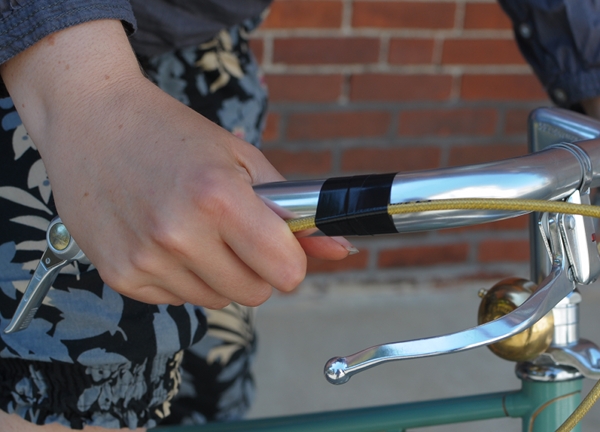 As you can see here, the Guidonnet levers don't allow you to brake from the upright position on the handlebars, but make you lean forward and move your hands closer to the stem. I find it counter-intuitive to brake in an aggressive position and shift in a relaxed position; should it not be the other way around? I will test ride the bike some more once we install the longer stem, but I suspect that I might have to admit that the Guidonnets were a mistake - which leaves the question of what to do instead.
As you can see here, the Guidonnet levers don't allow you to brake from the upright position on the handlebars, but make you lean forward and move your hands closer to the stem. I find it counter-intuitive to brake in an aggressive position and shift in a relaxed position; should it not be the other way around? I will test ride the bike some more once we install the longer stem, but I suspect that I might have to admit that the Guidonnets were a mistake - which leaves the question of what to do instead. [image via Reinassance Bicycles and ecovelo]
[image via Reinassance Bicycles and ecovelo]One possibility would be to install inverse brake levers (which I already have lying around) and fit the Silver shifters into a set of Paul's Thumbieshandlebar mounts, as Renaissance Bicycles has done on the build shown above. I have never seenSilver shifters mounted on the handlebarsbefore, only the (considerably less classic-looking)Shimanos. Having spoken to Bryan from Renaissance about it, I learned that he has rigged up a system to make the Silver set-up possible, and I am considering emulating it. The problem is, that the Co-Habitant is vehemently against this plan: He insists that placing the shifters on the handlebars would "cheapen a high end bike". I understand what he means, but I disagree when it comes to the Renaissance method involving the Silver shifters; I think it looks surprisingly elegant. Honest opinions?
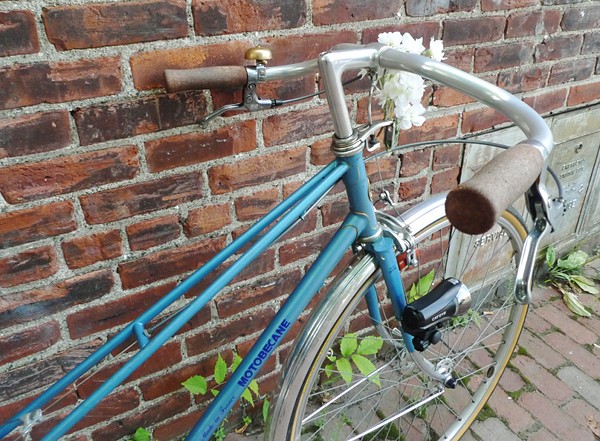 The alternative solution would be to get rid of the Porteur bars and take the Albatross bars from Marianne - installing them in the same upside-down manner, only with bar-end shifters and with the entire bar wrapped. I could do it, though I was really looking forward to havingthePorteurbars on this bicycle. Maybe there are other possibilities I am missing? I would like for this bicycle to retain a vintage French look, which I feel is better achieved with the Porteurs than with the upside-down Albatross. Suggestions welcome!
The alternative solution would be to get rid of the Porteur bars and take the Albatross bars from Marianne - installing them in the same upside-down manner, only with bar-end shifters and with the entire bar wrapped. I could do it, though I was really looking forward to havingthePorteurbars on this bicycle. Maybe there are other possibilities I am missing? I would like for this bicycle to retain a vintage French look, which I feel is better achieved with the Porteurs than with the upside-down Albatross. Suggestions welcome!{Edited to add: the Guidonnet levers have now been sold; thanks for your inquiries!}










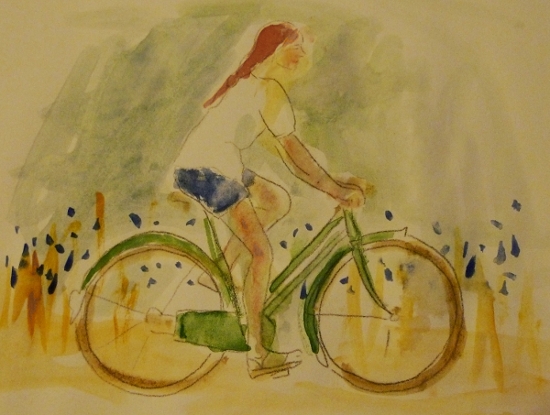 I have never drawn or painted bicycles before, but am now starting a commissioned painting that will include two female cyclists - so I've been making figure drawings and sketches of people on bikes. It has been interesting to study the postures our bodies adapt while cycling - and especially interesting to note the inherent attractiveness of those postures.
I have never drawn or painted bicycles before, but am now starting a commissioned painting that will include two female cyclists - so I've been making figure drawings and sketches of people on bikes. It has been interesting to study the postures our bodies adapt while cycling - and especially interesting to note the inherent attractiveness of those postures.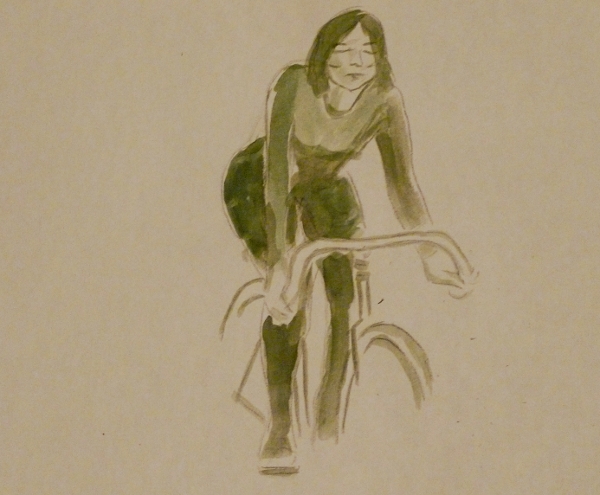 When it comes to the female figure, our positioning on a bicycle tends to really accentuate the waist-to-hip ratio - which, according to evolutionary psychology, is the greatest implicit indicator of "femaleness" to the male.
When it comes to the female figure, our positioning on a bicycle tends to really accentuate the waist-to-hip ratio - which, according to evolutionary psychology, is the greatest implicit indicator of "femaleness" to the male.  Cycling also tends to make the legs look longer and leaner - another evolutionary measure ofattractiveness,for both genders (researchers believe that long legs may have been indicators of hereditary longevity).
Cycling also tends to make the legs look longer and leaner - another evolutionary measure ofattractiveness,for both genders (researchers believe that long legs may have been indicators of hereditary longevity).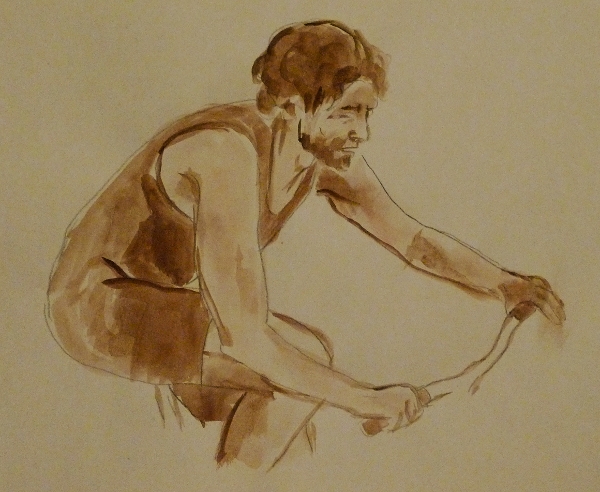 When we cycle, the muscle tone in our arms and legs is accentuated - a general sign of health. In males, this can also serve to suggest strength - which, according to evolutionary psychology once again, females are pre-disposed to respond to.
When we cycle, the muscle tone in our arms and legs is accentuated - a general sign of health. In males, this can also serve to suggest strength - which, according to evolutionary psychology once again, females are pre-disposed to respond to.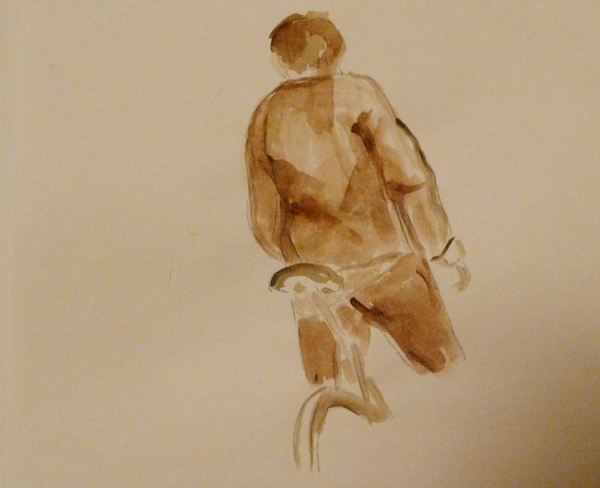 Finally, being on a bicycle raises the figure higher off the ground, literally making the cyclist seem taller - another advantage for males. The added height also makes the cyclist more noticeable, regardless of gender - placing their body on a moving pedestal of sorts.
Finally, being on a bicycle raises the figure higher off the ground, literally making the cyclist seem taller - another advantage for males. The added height also makes the cyclist more noticeable, regardless of gender - placing their body on a moving pedestal of sorts. One thing my cycling sketches have taught me, is that drawing the human figure on a bicycle is not easy - which makes it especially admirable that Mr. Rick Smith is able to do it nearly every single day with his comicYehuda Moon and the Kickstand Cyclery!
One thing my cycling sketches have taught me, is that drawing the human figure on a bicycle is not easy - which makes it especially admirable that Mr. Rick Smith is able to do it nearly every single day with his comicYehuda Moon and the Kickstand Cyclery! This bench was outside one shop door and looked like it was worth taking a picture of.
This bench was outside one shop door and looked like it was worth taking a picture of.


.JPG)






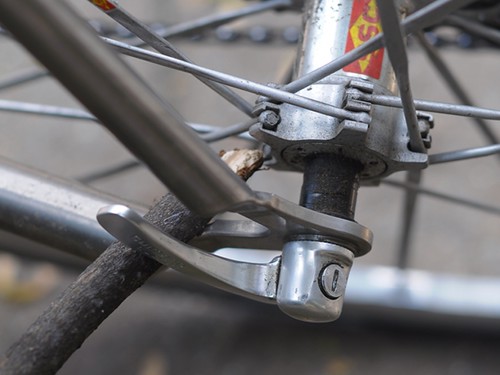 On the day after Irene we had beautiful weather and I went for a 40 mile ride on the Seven roadbike that I scandalously still have on loan (and will soon be reviewing). Though a preliminary cleanup of the roads had already taken place, branches and other debris were still scattered in some areas and I thought the biggest challenge would be cycling on narrow tires. However, that part was fine - the wheels rolled easily over the occasionally unavoidable obstacle, with the bike either retaining or quickly regaining stability every time. But toward the end of the ride I began to feel as if the rear wheel had an odd little bounce to it. It was barely perceptible, but I decided to stop and check it out - thinking it was probably a flat tire. What I saw was very different: The quick release of the rear wheel was open and the wheel was sitting completely loose in the dropouts. At first I thought that the lever was broken or the skewer had somehow snapped. But everything was fine and once I re-secured the wheel the bike was good to go. My theory is that a tough little branch must have gotten jammed in there, prying open the quick release. I suppose it was lucky that the wheel did not come out of the dropouts entirely, and lucky that the branch did not jam the spokes.
On the day after Irene we had beautiful weather and I went for a 40 mile ride on the Seven roadbike that I scandalously still have on loan (and will soon be reviewing). Though a preliminary cleanup of the roads had already taken place, branches and other debris were still scattered in some areas and I thought the biggest challenge would be cycling on narrow tires. However, that part was fine - the wheels rolled easily over the occasionally unavoidable obstacle, with the bike either retaining or quickly regaining stability every time. But toward the end of the ride I began to feel as if the rear wheel had an odd little bounce to it. It was barely perceptible, but I decided to stop and check it out - thinking it was probably a flat tire. What I saw was very different: The quick release of the rear wheel was open and the wheel was sitting completely loose in the dropouts. At first I thought that the lever was broken or the skewer had somehow snapped. But everything was fine and once I re-secured the wheel the bike was good to go. My theory is that a tough little branch must have gotten jammed in there, prying open the quick release. I suppose it was lucky that the wheel did not come out of the dropouts entirely, and lucky that the branch did not jam the spokes.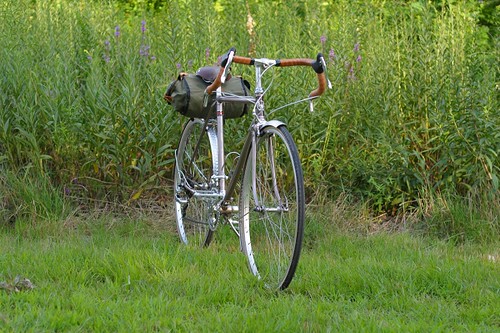 I am pleased to report that the refurbished vintage donation touring bike - also known as "the roadbike for women who fear roadbikes" - is ready! As often happens with these things, the project took longer than I anticipated. In the end we did not have time to put the bicycle together ourselves, and I entrusted the job to the saintly Jim at Harris Cyclery - which contributed the labor pro bono and donated the remaining parts my build was missing, thus becoming a sponsor of this project along with Velo Orange. My sincere thanks to them, as well as to all readers who contributed parts and funds to this effort. This is not yet the official give-away announcement, as I first wanted to show off some pictures and describe the bicycle in detail. I hope you like it!
I am pleased to report that the refurbished vintage donation touring bike - also known as "the roadbike for women who fear roadbikes" - is ready! As often happens with these things, the project took longer than I anticipated. In the end we did not have time to put the bicycle together ourselves, and I entrusted the job to the saintly Jim at Harris Cyclery - which contributed the labor pro bono and donated the remaining parts my build was missing, thus becoming a sponsor of this project along with Velo Orange. My sincere thanks to them, as well as to all readers who contributed parts and funds to this effort. This is not yet the official give-away announcement, as I first wanted to show off some pictures and describe the bicycle in detail. I hope you like it!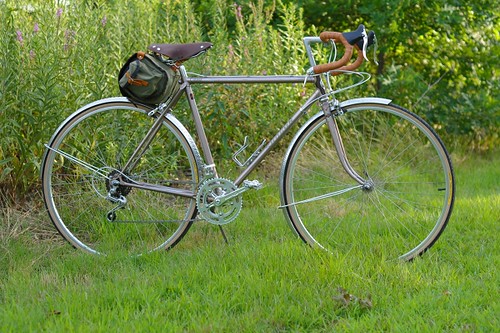 So what exactly is this bicycle... It began as a vintage Shogun 400 touring bike that looked like this when I picked it up, but has been rebuilt from the frame up. When I spotted the original bike, I immediately thought it had potential. The early '80s Japanese cro-moly frame with relaxed geometry promised a comfortable, "Rivendell-esque" ride. And, despite the fairly small size (52cm), it looked like there would be no toe overlap, even with fenders. As many know, it is extremely difficult to find a roadbike in a small size, with relaxed geometry and no toe overlap - be it modern or vintage - which is what makes some of these unassuming vintage Japanese frames special. My idea was to start with such a frame and build it up with comfortable, functional components - ending up with an unintimidating "starter" roadbike that a beginner would be able to learn on without undue nervousness or discomfort.
So what exactly is this bicycle... It began as a vintage Shogun 400 touring bike that looked like this when I picked it up, but has been rebuilt from the frame up. When I spotted the original bike, I immediately thought it had potential. The early '80s Japanese cro-moly frame with relaxed geometry promised a comfortable, "Rivendell-esque" ride. And, despite the fairly small size (52cm), it looked like there would be no toe overlap, even with fenders. As many know, it is extremely difficult to find a roadbike in a small size, with relaxed geometry and no toe overlap - be it modern or vintage - which is what makes some of these unassuming vintage Japanese frames special. My idea was to start with such a frame and build it up with comfortable, functional components - ending up with an unintimidating "starter" roadbike that a beginner would be able to learn on without undue nervousness or discomfort.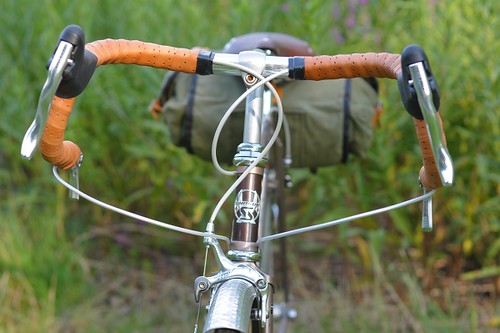 The biggest priority was the handlebar set-up. When women tell me they cannot ride vintage roadbikes, much of the time this turns out to be because the handlebars are uncomfortable - lacking a sufficient "shoulder" area. Those who are new to drop bars often assume that they are all the same, but in fact there are dozens of models, with subtle variations in shape. I chose theNitto Randonneur handlebars for this bike, which have long, flat "shoulders" and a slight, ergonomic flare to them that most cyclists find extremely comfortable, particularly on long rides.
The biggest priority was the handlebar set-up. When women tell me they cannot ride vintage roadbikes, much of the time this turns out to be because the handlebars are uncomfortable - lacking a sufficient "shoulder" area. Those who are new to drop bars often assume that they are all the same, but in fact there are dozens of models, with subtle variations in shape. I chose theNitto Randonneur handlebars for this bike, which have long, flat "shoulders" and a slight, ergonomic flare to them that most cyclists find extremely comfortable, particularly on long rides.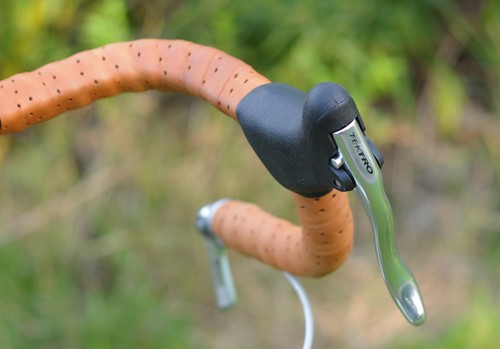 I also chose modernTektroshort-reach brake levers, which are easy to squeeze from the top, even for those with weak hands.
I also chose modernTektroshort-reach brake levers, which are easy to squeeze from the top, even for those with weak hands.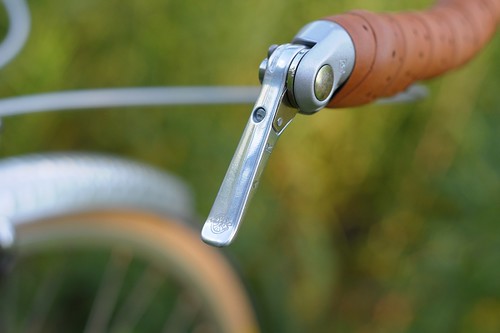 Finally, I chose Silver bar-end shifters, which are much, much easier to use than downtube shifters and less awkward than stem shifters.
Finally, I chose Silver bar-end shifters, which are much, much easier to use than downtube shifters and less awkward than stem shifters.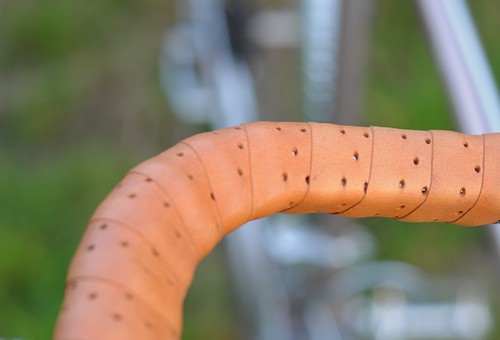 The leather handlebar tape is by Velo Orange. I had never tried it before and was glad to discover that it has a softer, more matte texture to it that Brooks leather tape (which I personally find a little too slippery).
The leather handlebar tape is by Velo Orange. I had never tried it before and was glad to discover that it has a softer, more matte texture to it that Brooks leather tape (which I personally find a little too slippery).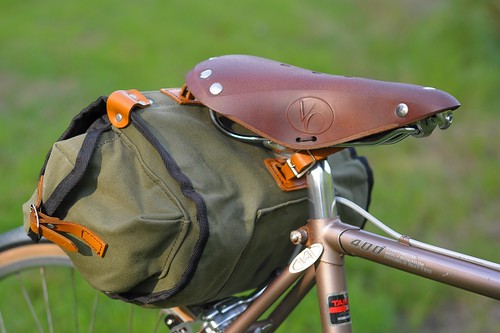 Velo OrangeModel 3 touring saddle. Saddle comfort is one of these things that is different for everyone, but I have to say that (somewhat to my surprise) I found this one more comfortable than the Brooks B17s I once owned. The leather is very different from Brooks leather, and I cannot speak for its longevity or durability. But for me, there was no "breaking in" period, and no pressure on sensitive body parts. I will soon write a review of this saddle with additional details.
Velo OrangeModel 3 touring saddle. Saddle comfort is one of these things that is different for everyone, but I have to say that (somewhat to my surprise) I found this one more comfortable than the Brooks B17s I once owned. The leather is very different from Brooks leather, and I cannot speak for its longevity or durability. But for me, there was no "breaking in" period, and no pressure on sensitive body parts. I will soon write a review of this saddle with additional details.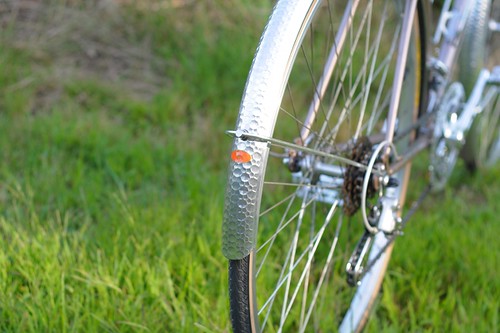 Velo Orangehammered fenders, their pattern of indentations resembling a honeycomb. Later I will also post a comparison between the VO and Honjo versions of hammered fenders.
Velo Orangehammered fenders, their pattern of indentations resembling a honeycomb. Later I will also post a comparison between the VO and Honjo versions of hammered fenders.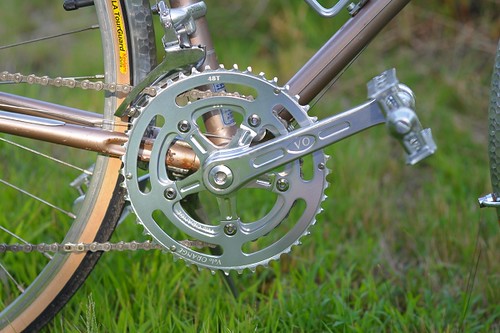 Velo Orange also provided the headset and their Grand Cru double crankset. It was exciting when these cranksets came out, because they are classically shaped yet affordable. Personally, I find the looks of chunkymodern cranksets rather depressing, so it's wonderful that these are an option.I have not ridden with them except during my test rides of this bike, but I welcome readers who've owned them to provide feedback. The pedals included are MKS Touring pedals, which I have on most of my bikes and love.
Velo Orange also provided the headset and their Grand Cru double crankset. It was exciting when these cranksets came out, because they are classically shaped yet affordable. Personally, I find the looks of chunkymodern cranksets rather depressing, so it's wonderful that these are an option.I have not ridden with them except during my test rides of this bike, but I welcome readers who've owned them to provide feedback. The pedals included are MKS Touring pedals, which I have on most of my bikes and love.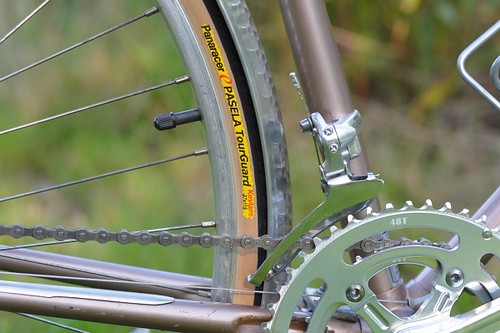 The wheels are 27" touring wheels from the early '80s - a slightly nicer and cleaner version than the ones originally on the bike. The tires are the puncture-resistant Panaracer Pasela Tourguards. The headset, bottom bracket, chain, brakes, and front derailleur have all been replaced with modern components.
The wheels are 27" touring wheels from the early '80s - a slightly nicer and cleaner version than the ones originally on the bike. The tires are the puncture-resistant Panaracer Pasela Tourguards. The headset, bottom bracket, chain, brakes, and front derailleur have all been replaced with modern components.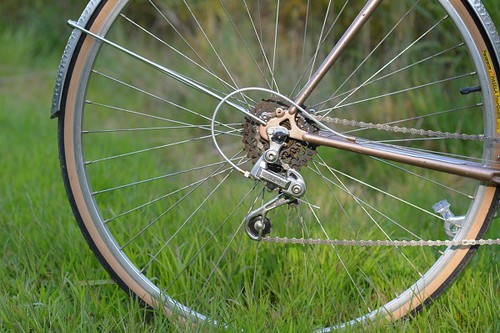 The rear cassette and derailleur are pretty much the only components that were left original. They are in good condition, but the downside is that the bicycle is only a 12 speed - as bikes of its era are. In order to upgrade to a cassette with more cogs, we would have needed to get modern wheels, which was beyond the scope of this project.
The rear cassette and derailleur are pretty much the only components that were left original. They are in good condition, but the downside is that the bicycle is only a 12 speed - as bikes of its era are. In order to upgrade to a cassette with more cogs, we would have needed to get modern wheels, which was beyond the scope of this project.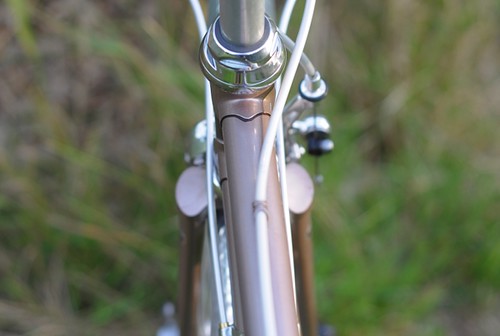 Here is a close-up of the bicycle's colour: an unusual champagne-lilac that I personally find very attractive.
Here is a close-up of the bicycle's colour: an unusual champagne-lilac that I personally find very attractive. 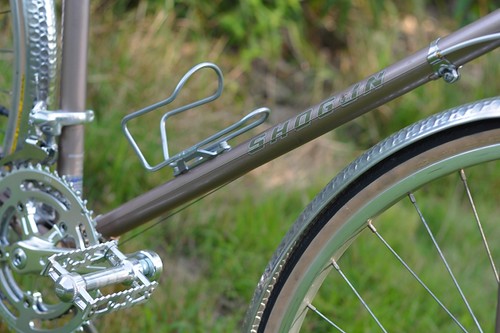 The frame has been left original - frayed decals, rust spots and all - and I want to make it very clear that at heart this is still a vintage bike that looks its age, despite the updated components.
The frame has been left original - frayed decals, rust spots and all - and I want to make it very clear that at heart this is still a vintage bike that looks its age, despite the updated components.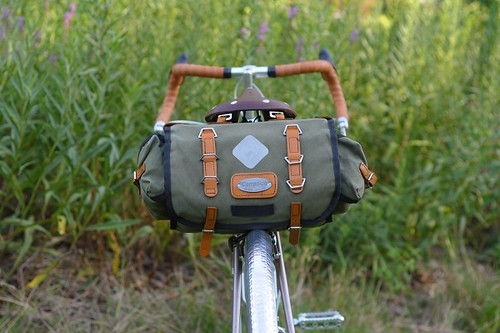 I received a Rivendell "SaddleSack" as a donation from one of my readers, but I think this bike works better with a Carradice. So I will let the recipient choose - either the SaddleSack, or one of my own Carradice bags, as shown here. I will soon post a review of the SaddleSack (pictured here).
I received a Rivendell "SaddleSack" as a donation from one of my readers, but I think this bike works better with a Carradice. So I will let the recipient choose - either the SaddleSack, or one of my own Carradice bags, as shown here. I will soon post a review of the SaddleSack (pictured here). 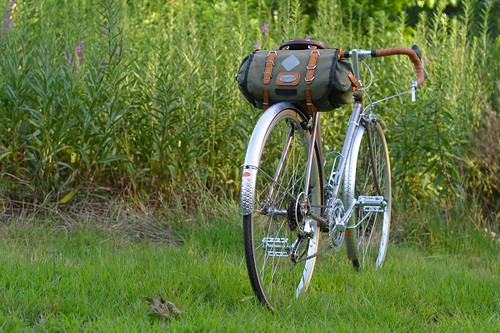 And so that's it, in a nutshell. To my eye, this bicycle looks modestly beautiful, which is what I was aiming for. It is fairly light and is easy to carry. It is not "fast" by modern roadbike standards, so please don't expect to race or join paceline rides on it. Neither is it a bike for a tour of the Alps, since the gearing is somewhat limited by current standards. It is really meant to be a low-key, introductory roadbike for those with no athletic background, for those who want to explore nature while getting a bit of exercise, and for those who don't want to wear lycra and be all "serious" about roadcycling. If you've been unable to ride roadbikes in the past, this bike may be a good alternative to the ones you've tried. It is friendly. It is stable. There is no toe overlap. Lots of room on the handlebars for moving your hands around. Brake levers are easy to reach and easy to squeeze. Frame geometry is relaxed and won't hurt your knees.Having ridden the bike myself for a bit, it handles as comfortably and easily as I hoped. I've even ridden it in a dress and sandals, and it was great - just a really easy-going, "smell the flowers" kind of bike. Bicycles with drop bars are not for everyone - but this is as unintimidating of a way to try one as I can offer. I will announce the contest rules and timeline in the coming days, and I hope this bicycle will find the right owner.
And so that's it, in a nutshell. To my eye, this bicycle looks modestly beautiful, which is what I was aiming for. It is fairly light and is easy to carry. It is not "fast" by modern roadbike standards, so please don't expect to race or join paceline rides on it. Neither is it a bike for a tour of the Alps, since the gearing is somewhat limited by current standards. It is really meant to be a low-key, introductory roadbike for those with no athletic background, for those who want to explore nature while getting a bit of exercise, and for those who don't want to wear lycra and be all "serious" about roadcycling. If you've been unable to ride roadbikes in the past, this bike may be a good alternative to the ones you've tried. It is friendly. It is stable. There is no toe overlap. Lots of room on the handlebars for moving your hands around. Brake levers are easy to reach and easy to squeeze. Frame geometry is relaxed and won't hurt your knees.Having ridden the bike myself for a bit, it handles as comfortably and easily as I hoped. I've even ridden it in a dress and sandals, and it was great - just a really easy-going, "smell the flowers" kind of bike. Bicycles with drop bars are not for everyone - but this is as unintimidating of a way to try one as I can offer. I will announce the contest rules and timeline in the coming days, and I hope this bicycle will find the right owner.